When Mahatma gave up expensive clothes in favour of Dhoti, it was seen as a revolution. For a Dalit to wear a three-piece suit, just like BR Ambedkar, is equally revolutionary. Why then is a Mahatma celebrated but a Dalit humiliated, even murdered?
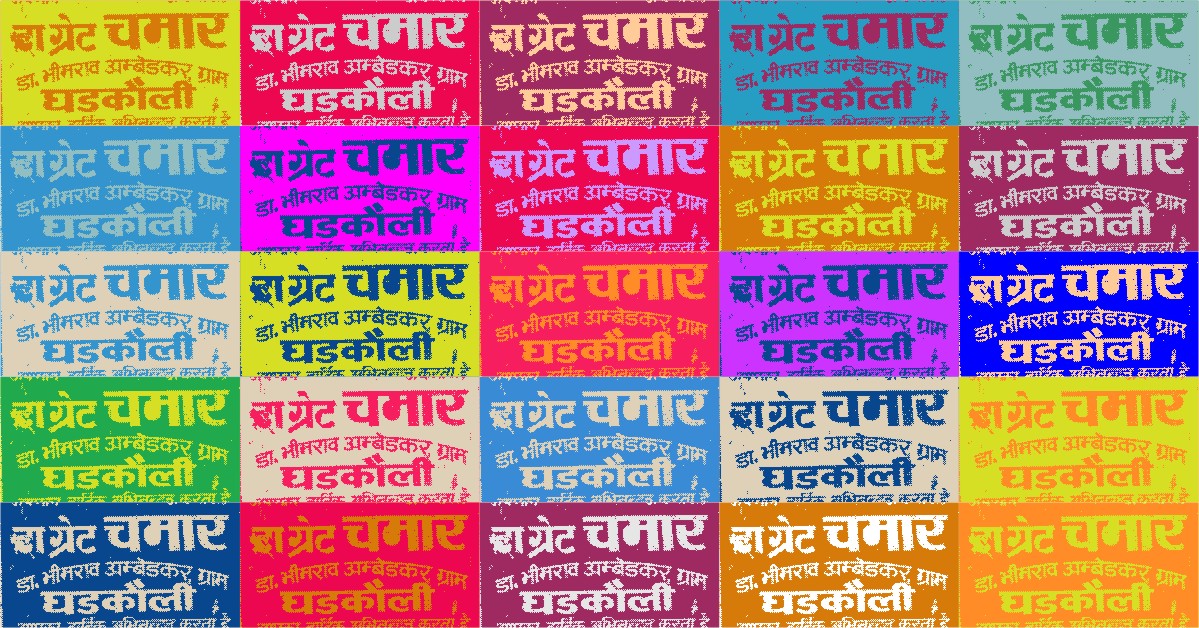
Image Courtesy: Amir Rizvi
Sanjay Jatav wore a proud blue coloured suit for his wedding on Sunday. He shone when he rode on a horse-drawn carriage through his bride’s village routes, a velvety red cushion providing contrast from the back, making his face more visible to the dancing crowd below.
It was the first time in 80 years that a Dalit wedding procession had crossed the path of a Thakur dominated village.
It is no surprise that the upper caste people in the village have seen green over his proud, blue and suited appearance. Threats to the bride’s family have been surreptitiously made, even though the ceremony received unprecedented security.
Over the last few years, Dalits have been threatened, killed, maligned and maimed for apparently breaking age-old caste rules that often look petty on the surface. It could be twirling a moustache, wearing a white shirt, riding a horse, jumping into a pond, dancing to music and even having a common Indian name.
On July 17, human rights advocacy group Amnesty International released its data recorded on its ‘Halt the Hate’ website. “In the first six months of 2018, 100 hate crimes have allegedly been committed against people from marginalised groups. 67 incidents of alleged hate crimes against Dalits and 22 against Muslims were recorded in just the first six months of 2018. 42 incidents involved killings and 13 involved sexual violence against women from marginalised groups,” the report said. UP topped the list of hate crimes followed closely by Gujarat.
When mostly Savarna movie critics do not appreciate the significance of Rajinikanth’s suits in the movie Kabali, it is wilful ignorance on their part. A mere slip of the upper caste gaze. As compared to when Dalits, or the marginalised, cross caste lines indelibly drawn through the centuries, a laxman rekha crafted to keep them subservient and meek. Why do such actions of assertion by a Dalit person or a person supposedly from a lower caste, draw such murderous ire?
Social patents justify caste violence?
Dalit rights activist Chandrashekhar Azad ‘Ravan’ took a militant approach to instil pride in every Dalit person. He twirled his moustache, wore a blue scarf and posed in front a banner which read ‘The Great Chamar welcome you to Gharkoli.’ The image drew immense focus on him and his politics. The UP govt wants to arbitrarily keep him behind bars (he has been in jail since June 2017) by slapping the draconian National Security Act against him. Why did his pride hurt upper caste sentiments so much?
A Dalit boy was murdered for wearing ‘Mojdi’s’ in Ahmedabad, Pradip Rathod was beaten to death for riding a horse in Gujarat and Maulik Jadav was beaten for adding the word ‘sinh’ to his name, also in the same western Indian state. A ‘sinh’ literally means a lion and Rajputs have claimed that name for themselves over centuries, apparently showcasing their bravery and past glory as warriors. Men were beaten for sporting moustaches and killed for watching the Garba dance in Gujarat. In Rajasthan, a mob attacked a Dalit wedding procession for playing a popular Bollywood song.
The answer lies in social patents.
“A social patent is a phenomenon in which dominant groups lay claim to exclusive enactments of social conduct, even of the most universal kind, apart from appropriating sartorial choices and facial hair styles for themselves. Their replication is then proscribed for the lower castes, who violate these social patents at their own peril,” wrote Ajaz Ashraf, a journalist from Delhi.
“A social patent is as restrictive as a manufacturing patent. Unlike products that are copyrighted, though, a social patent is a right that belongs to a group, not an individual. Social patents reward a social group not for its inventiveness but for ensuring that the inequality of status between its members and the downtrodden stays undiminished,” he added.
“A social patent determines who can sport a moustache, particularly of the sort that can be twirled. It decides who can hold a wedding procession, ride a horse to the bride’s house, hire a music band to strike notes of celebration. A social patent can debar a person from watching a dance performance, or riding a bicycle, or even wearing a white shirt. Social patents could include in their ambit any human activity likely to inject a sense of worth and joy among the lower castes,” he observed.
He said that the social patent of greatness lay with the Rajputs, so Azad claiming to be great while being a Chamar was an insult.
“Such stand-offs are a manifestation of a deeper struggle within society: Men and women from upper castes are increasingly anxious that Dalits – who makeup 16.3 percent of India’s population–previously considered untouchables, and relegated to jobs considered impure, are enrolling in schools in greater numbers, studying in colleges, finding better jobs and aspiring for long-denied equality,” reported Firstpost.
Could social patents be the only reason why traditionally advantaged classes resent the assertion of ‘inferior’ or ‘lower’ castes in personal and social politics?
Talking about upper caste insecurity, an article in DailyO said, “As modernisation and liberalisation create their own classes of the disadvantaged and take away tangible manifestations of their superiority – land, money – from some upper-class groups, they then hold onto the trappings even more fiercely. Any Dalit making pretensions to what had been their prerogative – leisure (attending garbas), pride (moustache, horse, dressing well) – has to be struck down, surely and swiftly. This attitude is by no means limited to rural societies alone. In the poshest of circles, Dalits most often exist only as ‘projects’ to be patronised, not equal humans to be fraternised with.”
Paying the price for existing
The legend of Nangeli from Kerala is proof of how caste bias meant one had to pay a heavy price for being born. Even though the practice of taxing the backward and lower castes just for being themselves existed 300 years ago, the struggle for asserting their fundamental rights hasn’t quite ended.
“Over three hundred years ago, the southern state of Kerala had a system of taxation, whereby women belonging to backward castes and Dalits had to pay a tax, if they wanted to cover their breasts. Standing bare chested was taken as a sign of respect towards those castes supposedly “superior” to them – for both men and women. The tax however, was levied only on Avarna (lower caste) women who wanted to cover their chest. It goes without saying that some of these “superiors” would have also got their voyeuristic kicks out of this system as well. Royal officials would travel door to door, collecting this heinous “Mulakkaram” – literally Breast Tax- from Avarna women who had passed puberty. Sickeningly, the amount would depend on the size of the breasts,” wrote Supriya Unni Nair, a journalist from Bengaluru.
Nangeli had had enough of this humiliation. “When the pravarthiyar, or village collector came asking for her share, she lit a lamp and laid down a plantain leaf as per the custom, but instead of money, she cut off her breasts and placed them on the leaf, shocking the officials,” she wrote.
Having a name killed a minor boy in UP in 2011. “Ram Sumer and Jawahar Chaudhary have sons named Neeraj and Dheeraj and that has long been an issue between the two families, Sub-inspector Praveen Kumar said. Mr Chaudhary, who belongs to a higher caste, had given several warnings to Mr Sumer to change the names of his boys. On 22 November, Neeraj left home after dinner to watch television at a friend’s house. His body was found the next day. Police said he was strangled,” reported BBC.
A Dalit man was killed in Jharkhand for celebrating the festival of colours. In 2017, the police beat 52-year-old Pradeep Choudhary to death for ‘daring’ to throw colour on a man. He and his friends had thrown colour at a local chowkidar on Holi. The man then called the police to ‘teach them a lesson. Another Dalit man from the same state was tonsured and paraded in his village in 2015, on the suspicion of lighting the Holika pyre.
When did celebrating a festival become a death sentence?
The emperor’s new clothes
Those aware of the fairy tale know how dangerous ignorance and blind fear can be.
While the upper castes find varied ways to secure their social hierarchy’s, they also find ways to not let those they consider below them to ever question their place.
Lessons in caste began early in a Tamil Nadu school where students had to wear wristbands with colour codes based on caste.
“It’s red and yellow for Thevars, blue and yellow for Nadars, saffron for Yadavs — all socially and politically powerful Hindu communities that come under the Most Backward Classes (MBC) category — while students of the Dalit community of Pallars wear wrist bands in green and red and the Arundhathiyars, also Dalits, wear green, black and white,” reported the Indian Express in 2015.
The colour of their tilak on their forehead is also a code for caste. “The headmaster at a school near Tirunelveli town said there were other markers. “Like you have different houses — green house, yellow house, etc — in city schools, children here wear coloured vests. We cannot ban everything, definitely not what children wear under their uniform. These vests come in handy during a game of basketball to draw up teams based on caste lines, but they are as effective to settle scores,” he said in the report.
In 2012, A Dalit man was beaten up for wearing a white shirt.
“Clothing, a symbol of social standing and power, has also been an instrument of oppression and an integral tool for determining and imposing identity in traditional Indian caste-hierarchies,” wrote Sunaina Kumar in Scroll.
“These codes of dressing have been a part of the wider social structure across India and anytime they have been broken, there have been reprisals from the upper castes. In Rajasthan, Dalit men were forbidden from wearing colourful pagdis and punished and thrashed if they dared to do so. In Tamil Nadu, lower caste men were forbidden from folding up their lungis and had to wear it to their toes. In parts of the state, this rule still applies. Dalits were generally not allowed to wear clean, bright or new clothes or sandals. In some places, if a Dalit wore new clothes, they had to be smeared with soot so they would appear unclean. Dalit women were not allowed to wear gold or silver jewellery, or saris in which gold thread was used,” she wrote.
The article makes a thought-provoking point. When Mahatma gave up expensive clothes in favour of the Dhoti, it was seen as a revolution. For a Dalit to wear a three piece suit, just like BR Ambedkar, is equally revolutionary. Why then is a Mahatma celebrated but a Dalit murdered?
Dehumanising people to perpetuate caste bias
‘Bhangi,’ ‘Chamar,’ ‘Harijan,’ are just some words that are used to deny basic human dignity to people from ‘lower castes.’ They are seen as pollutants to the ‘upper caste’ hegemony. A group of Dalit boys were paraded naked after being beaten in a village because they dared to ‘pollute’ a well by swimming in it to beat the summer heat.
Not just people in the patriarchal social hierarchy that traditional Hindus follow, Muslims are also called words and names to strip away their humanity. “Barbaric,’ ‘dirty,’ ‘Katua,’ (meaning circumcised,) are just some words used to describe Muslim people in the country.
Excerpts from the book ‘Genocidal Nightmares: Narratives of Insecurity and the Logic of Mass Atrocities,’ show how masses justify their violence against minorities by dehumanising them. It is written by Dr. Abdelwahab El-Affendi, originally from Sudan, Dean of the School of Social Sciences and Humanities, Professor of Politics at Doha Univeristy and Co-Ordinator of University of Westminster’s Democracy and Islam Programme since 1998. He wrote about what preceded the Gujarat 2002 carnage.
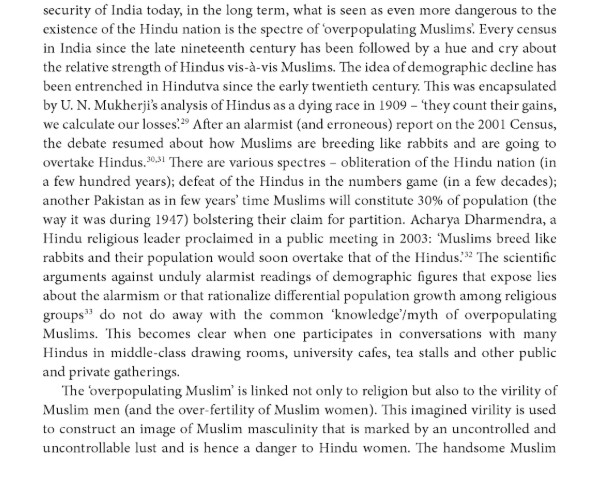
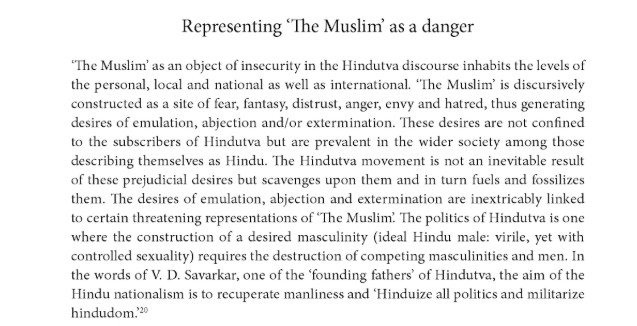
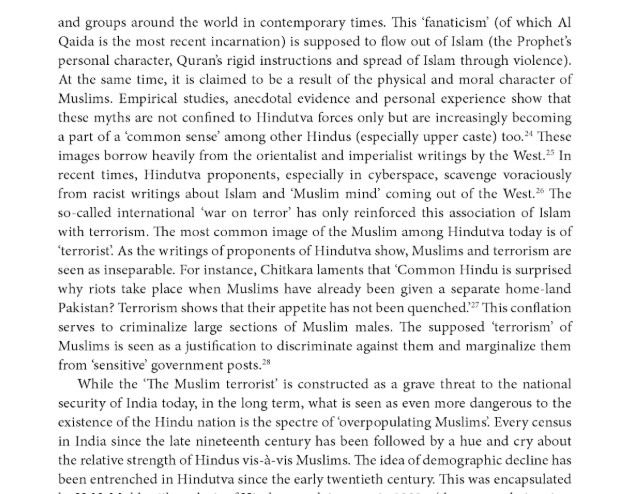
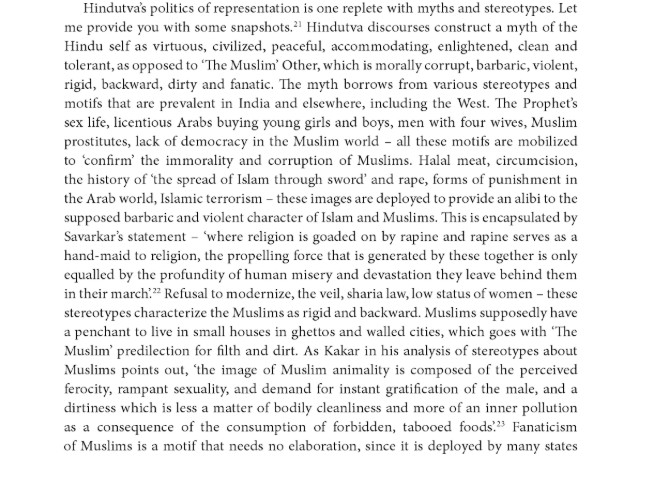
[Embed 1,2,3,4 screenshots]
Caste bias during Ambedkar’s time
BR Ambedkar seminal work, ‘Annihilation of Caste,’ is compulsory reading material to learn about caste. On December 12, 1935, Bhimrao Ambedkar had been asked by the Jat-Pat Todak Mandal (Society for the Abolition of Caste System), a Hindu reformist group, to address their annual conference and speak about the ill-effects of caste in Hindu society. When he sent them ‘Annihilation of Caste,” they responded by asking him to delete certain paragraphs. He responded by saying that he would not change a single comma.
He was swiftly uninvited and his speech lay undelivered. He published it himself and the rest is history. Excerpts from the speech show how caste symbols were used to defile and denigrate people:
Under the rule of the Peshwas in the Maratha country the untouchable was not allowed to use the public streets if a Hindu was coming along lest he should pollute the Hindu by his shadow. The untouchable was required to have a black thread either on his wrist or in his neck as a sign or a mark to prevent the Hindus from getting themselves polluted by his touch through mistake. In Poona, the capital of the Peshwa, the untouchable was required to carry, strung from his waist, a broom to sweep away from behind the dust he treaded on lest a Hindu walking on the same should be polluted. In Poona, the untouchable was required to carry an earthen pot, hung in his neck wherever he went, for holding his spit lest his spit falling on earth should pollute a Hindu who might unknowingly happen to tread on it. Let me take more recent facts. The tyranny practised by the Hindus upon the Balais, an untouchable community in Central India, will serve my purpose. You will find a report of this in the Times of India of 4th January 1928. ” A correspondent of the Times of India reported that high caste Hindus, viz. Kalotas, Rajputs and Brahmins including the Patels and Patwaris of villages of Kanaria, Bicholi-Hafsi, Bicholi-Mardana and of about 15 other villages in the Indore district (of the Indore State) informed the Balais of their respective villages that if they wished to live among them they must conform to the following rules:
(1) Balais must not wear gold-lace-bordered pugrees.
(2) They must not wear dhotis with coloured or fancy borders.
(3) They must convey intimation of the death of any Hindu to relatives of the deceased—no matter how far away these relatives may be living.
(4) In all Hindu marriages, Balais must play music before the processions and during the marriage.
(5) Balai women must not wear gold or silver ornaments; they must not wear fancy gowns or jackets.
(6) Balai women must attend all cases of confinement of Hindu women.
(7) Balais must render services without demanding remuneration and must accept whatever a Hindu is pleased to give.
(8) If the Balais do not agree to abide by these terms they must clear out of the villages. The Balais refused to comply; and the Hindu element proceeded against them. Balais were not allowed to get water from the village wells; they were not allowed to let go their cattle to graze. Balais were prohibited from passing through land owned by a Hindu, so that if the field of a Balai was surrounded by fields owned by Hindus, the Balai could have no access to his own field. The Hindus also let their cattle graze down the fields of Balais. The Balais submitted petitions to the Darbar against these persecutions; but as they could get no timely relief, and the oppression continued, hundreds of Balais with their wives and children were obliged to abandon their homes in which their ancestors lived for generations and to migrate to adjoining States, viz. to villages in Dhar, Dewas, Bagli, Bhopal, Gwalior and other States. What happened to them in their new homes may for the present be left out of our consideration.
The whole episode and the rest of the speech can be read here.
Donald Trump and the Nazi Throwback
Dehumanising language and words have been commonly used throughout history to deny human rights to people and even justify their genocide. World media could not stop from making parallels between Donald trump’s diatribe against immigrants and Nazi propaganda employed to wipe out Jews.
He informed the world like he usually does, with a tweet. He called immigrants infestations. “Democrats are the problem. They don’t care about crime and want illegal immigrants, no matter how bad they may be, to pour into and infest our Country, like MS-13. They can’t win on their terrible policies, so they view them as potential voters!” he tweeted.
Infestations are caused by insects. Adolf Hitler consistently propagated this view about Jews. He compared them to rats and demanded their ‘extermination’ and eradication. The propaganda lead to the genocide of 6 million Jewish people.

https://www.youtube.com/watch?time_continue=1015&v=XlGFeSFP78s&bpctr=1531991161
“The use of the word “infest” to talk about people is literally out of the Nazi/anti-Semites’ playbook for talking about the Jewish threat. It was also a standard for talking about Chinese in the western United States and it remains part of the vocabulary for talking about Romani (Gypsies) in parts of Europe. This is the most hard-boiled kind of racist demagogic language, the kind that in other parts of the world has often preceded and signalled the onset of exterminationist violence. The verb “to infest” is one generally used to describe insects or vermin (rats), creatures which are literally exterminated when they become present in a house or building or neighbourhood,” said Josh Marshall, editor and Polk award winner.
Rwandan genocidaires also claimed that their victims, the Tutsi people, were cockroaches and snakes that had to be wiped out.
Closer home, all we need is the life of a dog, to dehumanise a person. Dilip Mandal wrote a searing essay ‘Just like a Dog’ in Sabrang India about how the animal has been used by Indian politicians to pardon violence and rid the criminals of guilt.
“Dogs are so prominent in mythology that we just can not ignore them. They are all over. As in the consciousness of General Singh. In the Mahabharata, the dog is the only companion of Yudhishthira in his journey to heaven, the dog is also present as a pathetic creature in the story of Drona and Ekalavya. In the 13th century Telugu text called Vijnaneshvaramu, as cited in the journal Modern Asian Studies (43-1) there is mention: if a Brahmin commits a crime deserving capital punishment, this is what should be done: shave his head, mark his forehead with the sign of a dog’s paw and so on. For others, less fortuitously born, the punishment is going to the gallows. So there is always some poor dog, or a dog reference, during life and even after death, the after life,” he wrote.
Perpetuating violence in the name of religion
What has happened in the name of various religions over the past four years is not news.
Centuries-old dehumanising customs are making a comeback and being used to deny basic human rights enshrined in the Constitution and practised in the 21st century today. What changed in the last few years that caste biases, symbols, nomenclature and language became the sole obsession of the country?
“Last week, RSS chief Mohan Bhagwat told a gathering at the Bombay Stock Exchange that politicians are compelled to practise caste politics because society votes on the basis of caste, that even those politicians who would seek to change caste politics feel compelled to pander to it first. Bhagwat’s portrayal of caste politics as a sort of necessary evil reflects the RSS-BJP world-view, which perceives caste primarily as an impediment to the forging of political unity of Hindus. A corollary is the refusal to acknowledge that caste politics has provided agency to historically disprivileged communities to fight social and political exclusion,” an Op-Ed of The Indian Express read.
Harish S. Wankhede, a professor at JNU summarised the hatred for Dalit assertion in politics. “Rashtriya Swayamsevak Sangh (RSS) understands the dynamic legacy of the Dalit movement in disturbing the Hindutva’s ideological rigour. Hence, to neutralise the impact of Dalit assertion on the political and social fronts, the right wing forces have improvised their tactics at both levels. On the political front, the BJP is showcasing its inclusive character; however, in the social sphere, the right wing is using anti-Dalit sentiments to consolidate its political base,” he wrote in The Wire.
“A recent study by the University of Pennsylvania under Social Attitude Research for India highlights that large sections within the upper-middle class society still hold explicit prejudices against the Dalits. Brahmanical conservatism grips the social psyche even in times of high-modernity and refuses to change. Social relationships are still disciplined through caste and communal prejudices. Muslims and Dalits face humiliation and violence everyday because of the ingrained hatred constructed by the conservative Brahmanical social values. The agenda of social reform, therefore, remains incomplete, as the radical transformation of social attitudes needs annihilation of caste pride. The social elites have not only resisted the agenda of social reforms, but have also categorically treated those who stood against Brahmanical values, rituals and customs as anti-social. The claims for constitutional safeguards, reservation policy and social dignity by the Dalits are often belittled as demands of ‘freeloaders’ and ‘non-meritorious’ people,” he wrote.
“The way Muslims as the ‘political other’ are required to be submissive to majoritarian Hindu communalism, the Ambedkarite Dalit minority, too, is being projected as the new ‘social other’ to help the right-wing mobilise conservative Brahmanical Hindus. One can see such trends, especially in UP and Maharashtra, where ideologically committed Dalit castes, like Jatavs and Mahars, are being projected as ‘aggressive’ anti-Hindutva castes. The Ambedkarite Dalits are thus branded as counter-culturists to the collective will of the Hindus and, therefore, as ‘anti-social’ and ‘anti-national,’ he added.
“The BJP is trying hard to retain its conventional upper caste support. It is pretty clear that the right wing is consciously trying to engineer a broad social alliance of upper castes and other dominant castes by projecting Ambedkarite Dalits as a new militant social “enemy,” he said.
When will we stop seeing these clearly caste-based provocations as a ‘minor skirmish,’ ‘isolated incident’ and ‘personal feud’ and call out the bullshit for what it is- a social and moral decline of a country. A rigid refusal to grow out of the retrograde custom, some sanctified by ancient scripture and move on, to embrace new realities. A cancer of the human community.
The writing is on the wall.